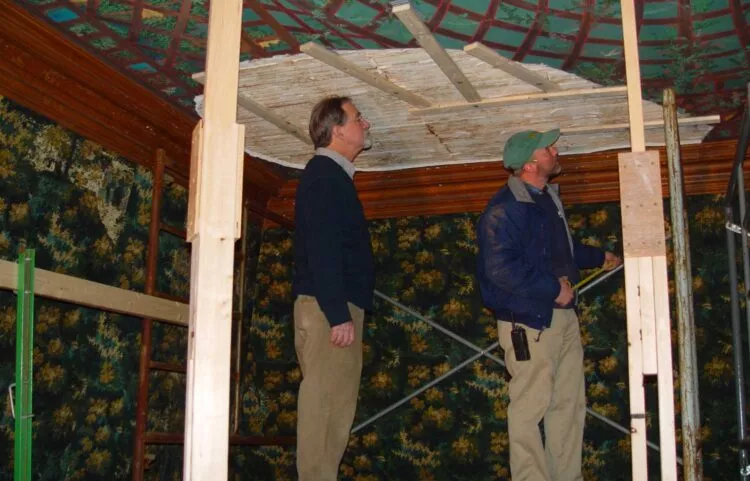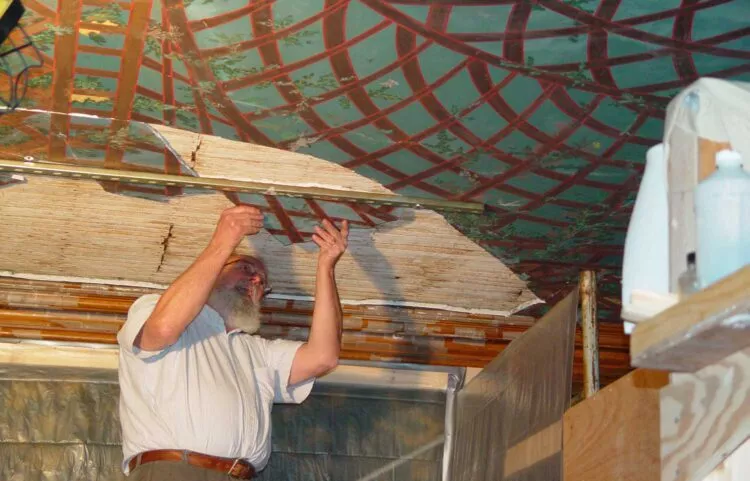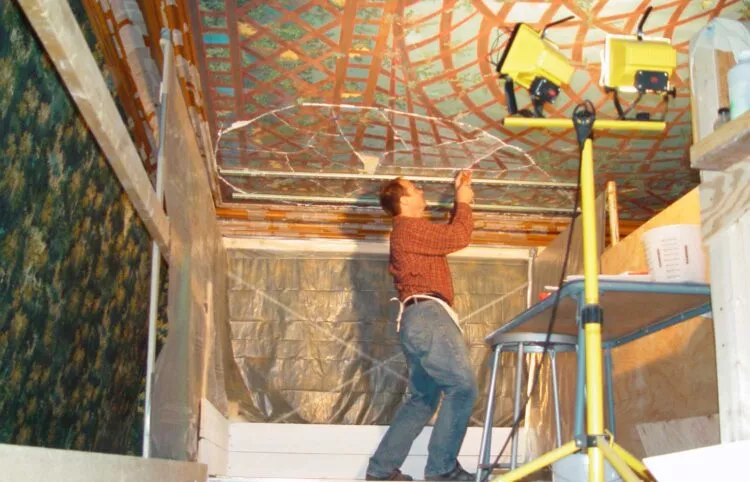Chateau-sur-Mer
Chateau-sur-Mer: Restoring a Collapsed Ceiling
In late 2007, a five-by-seven foot section of weakened plaster fell from the 3rd floor ceiling of the main staircase at Chateau-sur-Mer and broke into thousands of fragments, narrowly missing recently-restored light fixtures, a chair and suit of armor on the landing between the second and third floors. The collapsed ceiling included an extension of the Tree of Life that is painted on the backside of the staircase—a free-hand painted lattice interlaced with foliage and the occasional bird and butterfly. The ceiling painting dates to the 1870s renovation of the house by architect Richard Morris Hunt.

The ceiling collapse was caused by a confluence of several events: leaking water over the decades, which damaged the plaster; significant structural cracking due to historic settlement of the building; and especially the fact that the original plasterers did not apply the plaster to the ceiling properly, failing to create enough “keys” to attach it to the support beams above and reducing its holding power.
Broken plaster fragments were carefully collected so that conservation staff members could re-assemble the pieces to identify the pattern. After appropriate study, a proper treatment was identified, including re-plastering the area, correctly compensating for the lost decorative paint, even replacing the broken fragments.

A substantial scaffolding was built to allow access to the ceiling for further study and treatment, and to support the remaining ceiling areas to prevent further loss. Carpenters also opened the flooring above the damaged ceiling to allow access for study and repair.

In 2011, the repair and re-installation of the damaged section of ceiling was completed. Starting with small shards and fragments of painted plaster, conservation staff members and interns gradually matched the pieces into larger segments, then those segments into increasingly larger sections. Those sections were further patched and in-painted where losses existed.

The larger pieces were re-installed in the missing 5×7 foot section of the ceiling. Additional patching and in-painting was done on site to complete the repair.
Preserving a Great Victorian House
The Preservation Society completed a major, multi-million dollar restoration of Chateau-sur-Mer’s roof, which protects the treasured woodwork, wallpapers, stencils and furnishings inside.
Chateau-sur-Mer (1852) is one of America’s great Victorian houses. Victorian society looked to a future built on industrial wealth and science, while its art looked to the past, inspired by a romantic fascination for history, nature, and adventures in exotic lands. Chateau-sur-Mer is a landmark to all of these Victorian interests.
With a vast fortune in the China Trade, three generations of the Wetmore family lived at Chateau-sur-Mer and worked with some of the nation’s leading architects and landscape designers to make the estate one of the most palatial in Newport. Italian woodwork, Chinese porcelains, Egyptian and Japanese Revival stencils, and rare trees from Kentucky to Mongolia are just a few of the precious things assembled by the family on this most remarkable estate.
Prominent in international trade and finance, society, politics, and art, the Wetmores were a major presence in 19th century life and Chateau-sur-Mer was the backdrop for all of their activities. George Peabody Wetmore served as Governor of Rhode Island and as a U.S. Senator. His daughters, Maude and Edith, were art collectors and preservationists. Upon the death of Edith Wetmore in 1966, Chateau-sur-Mer faced an auction and imminent destruction. The Preservation Society of Newport County intervened and saved the house and fine park of trees. Today, the estate is a National Historic Landmark and a place where the romantic atmosphere and cultural values of the Victorian Age are preserved in the picturesque grounds and richly crafted rooms.

